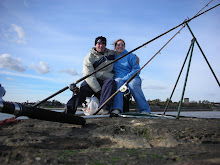




How I dig Lugworm
I have always been fascinated by the beach at low water and learned from an early age how to dig Lug without too much effort. I only wish I were as good at catching the fish! This guide will help you to identify and dig a successful batch of lugworm for your fishing needs….
First things first, you will need a sturdy fork - one with 4 wide tines and a metal shaft will be best. Oh yes, and then a bucket (please do look for signs and/or check local byelaws to make sure you are allowed to dig holes on the beach). Try, if you can, to avoid digging where swimmers will be when the tide comes in. We don’t want toddlers disappearing into one of the holes you have left!
You will also need to find a piece of beach that contains Lugworm - sandy beaches are the best. The best digging will be found after low water when the tide starts to come in. The worms seem to be more active at this time (making wormcasts).
Now you need to look for the wormcasts and the associated holes. If you want to avoid too much digging with no results you really need to find the hole in the sand that belongs to the wormcast (See 1st picture.) The hole is usually between 6” to 15” from the wormcast.
Once you have identified the cast and the hole, stand behind the wormcast and look towards the hole, insert the fork halfway between the cast and the hole.
Remove the spoil and set to one side. Then move the fork back behind the cast and push the fork in all the way and then a further 4” to be nice and deep. See 4th picture.
Push the fork forward to loosen the sand. Carefully remove the spoil, turn upside down and put to one side. The worm should be easily spotted. See last picture.
Carefully pick up the worm and place in the bucket. Sometimes the worms will be found living deeper and you will need a third forkful to find the worm. The worms will usually be deep if the weather is really cold. I find that 9 times out of 10, the worms will be undamaged when dug using this method. Of course, there are times when the worm casts are numerous - if so, you can just dig a trench through them but I do not find them in this heavy concentration very often and you will get more damaged worms by just digging through the casts.
Note: - I tried using the Alvey narrow bait pump and had some limited success. It depends on the composition of the beach. The beach composition here at Harwich varies a bit too much between sand, pebbles and mud. I found that I got more worms with the fork than the bait pump.
I keep the worms in a bucket until I get home and then I sort out the undamaged worms and lay out on newspaper. If I am going fishing the same day then I will use the damaged worms otherwise I will feed them to my Koi! I then sort the healthy worms into groups of 20 and wrap them in dry newspaper and keep in the Fridge. The will keep up to about 5 days in this way.
I now have a fairly frequent blog on my fishing activities. You can find this at lugworm.org
A little bit about me: -
My name is Paul Good and I live in Harwich, Essex, England. I am 52 years old and am self-employed. I dig worms professionally but only on a limited basis. In addition I have a Caravan/Camping accessory business. I also buy and sell anything I like the look of! You can find my other activities on Ebay at either yumyumgoody, paulgood13 and paulscaravanparts
Are you looking for Lugworm?
Any questions email: - paul@paulgood13.wanadoo.co.uk
Good luck!!
P.S. I like digging worms in the summer but I don't get so many because the Ladies in Bikinis are a big distraction!

P.P.S. I also salt the lugworm. They make a great bait for seafish and carp. I have also made a short video on how I dig Lugworm. See below

No comments:
Post a Comment